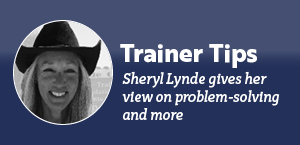
By Sheryl Lynde | Horsetrader columnist
In my new book Riding from the Heart, I highlight the many parallels between the human and the horse, trying to take the mystery out of their respective behaviors. If we can draw from our own experiences, we may gain an insight into their reactions.
I should clarify that I am not referring to anthropomorphic terms — defined as “having human attributes.” There is a huge difference between looking at parallel behaviors and simply applying human attributes to a horse’s behavior. Horses may show affection and express emotions similar to humans such as fear, and aggression or lack of respect, but they are 1,000-pound animals with entirely different instincts.
I am referring to a common thread we share in how we react to life situations. For instance, we have all experienced a friend’s need to be talked off the proverbial ledge. They may have suffered a traumatic event or loss that has left them shaken. and are unable to focus — chaotic in their emotions and thought processes. What do you do? Do you raise your emotions to their level and confirm the seemingly disastrous turn their life has taken? Or, do you listen, observe, and think how best you can serve your friend while remaining as calm as possible? The more distraught the friend, the quieter you become.
With me, I wait. I want to give them an opportunity to find a solution, a way out, a way to recover. However, if I see they are spiralling out of control, I intervene. I’ll help them devise a plan and break that plan into steps they can easily manage — steps they can accomplish, steps that give them direction, that allow them to breathe and provide hope.
When working a horse with behavioral issues, I quietly observe. I watch how the owner handles their horse. Their interaction speaks volumes. If the owner feels comfortable to ride, great, I observe their communication between one another, allowing the story to unfold.
Once I begin working the horse, we start in the round pen. I ask questions by sending the horse off and observing his reactions to cues. The more explosive his reactions, the quieter I become, not a quiet born of timidity, but a quiet that speaks of a calm resolve. I observe: Is the horse capable of making good decisions? Is he responsive to my cues rather than reactive? Is he aggressive, testing my role as leader, or disrespectful — trying to push back as if I was a subordinate below him in the pecking order? Is he an overachiever, performing tasks with too much energy, too quickly, too habitually without a connection to me or change in demeanor? Is he fearful, wanting to escape from my cues, running about chaotically with his nose to the outside of the pen?
As with listening to a friend in crisis, if the horse is spiralling out of control I devise a plan based on their specific issue and break the plan down into steps the horse can accomplish. With the aggressive and disrespectful horse, my demeanor is firm, not aggressive. I’ll ask for outside turns with their nose toward the outside of the pen. This prohibits them from charging me, teaching them to respect my space. These horses aren’t looking for a leader and they challenge anyone attempting to take that role. Outside turns give me the ability to direct their feet safely while controlling their speed and providing guidance. By observing, I can deflect a thought — like an attempt in the making to challenge me. Before they can follow through with the impulse, I turn them to the outside, increasing the space between us and assuring my safety.
If you want their attention, you have to give them your attention. You cannot buy their trust or respect, you earn it. Make your boundaries known. Your personal relationships mirror what you project. Do people often take advantage of you? Remember, just as you teach people how to treat you, you teach the horse as well. Allowing disrespectful behavior from people is demeaning; allowing that behavior to go uncorrected with a 1,000-pound animal is dangerous. With a fearful horse, a calm and consistent demeanor is key. Instruction should be given with the same demeanor yesterday as today — with patience and a clear purpose. When someone is kind one moment, then explosive and erratic the next, their behavior fosters feelings of unease. When kindness is shown, it isn’t trusted. Trust cannot be established when someone is consistently inconsistent. Actions define us, words disguise us.
Unlike humans, horses don’t belie their emotions. A horse becomes wary, on guard with unjust behavior, like we do. If you can make the connection to the human scenario, you are better able to identify the root cause of the horse’s reaction. The parallels between the human and the horse are significant. Can you see them?
–Sheryl
Leave a Comment
All fields must be filled in to leave a message.